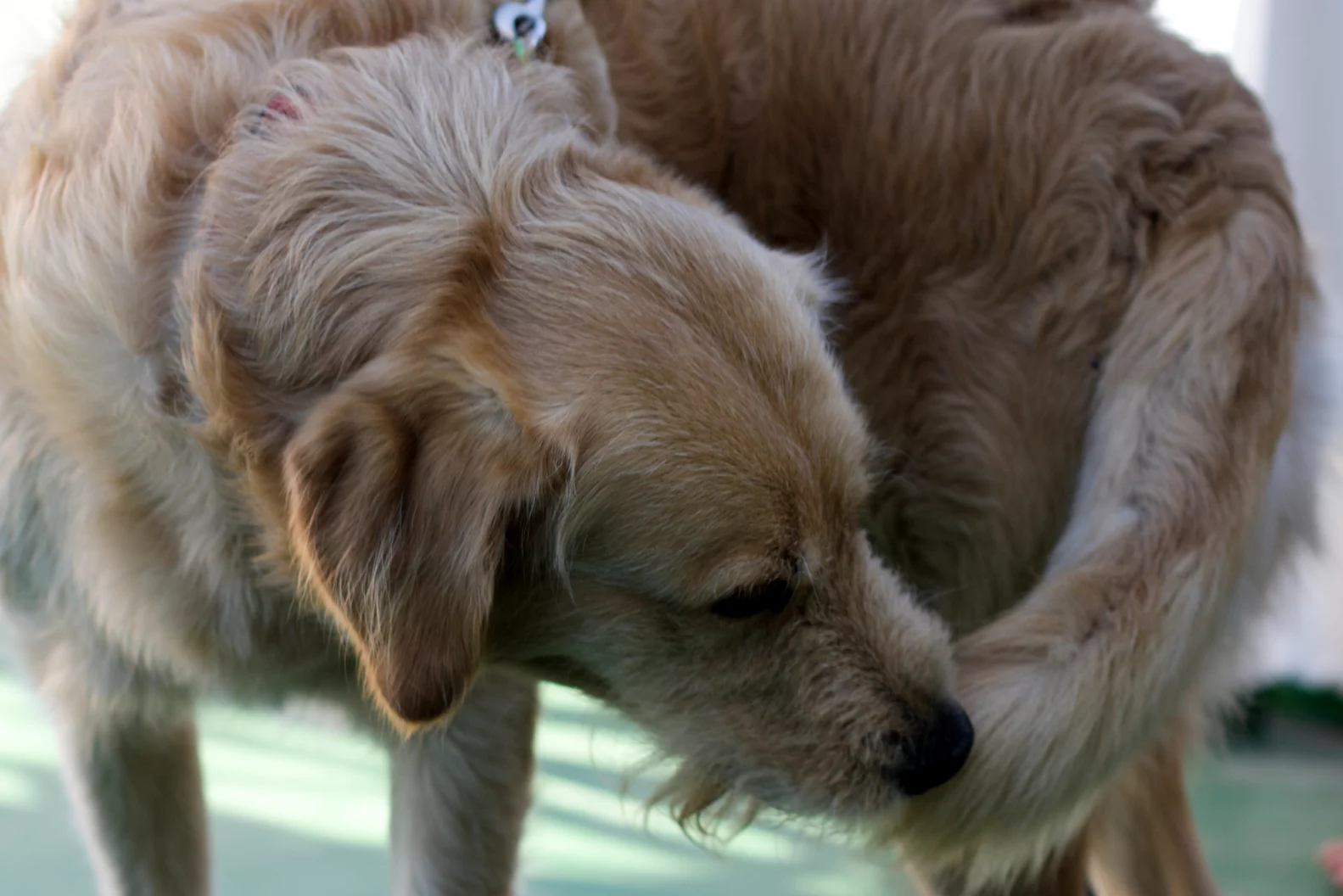Why Does My Dog Chase His Tail When He’s Excited?

Dog Chase His Tail When Excited
One possible explanation for tail chasing is that it stems from a dog’s natural predatory instincts. Dogs are descendants of wolves, and their hunting instincts are still deeply ingrained within them. When a dog sees its tail moving, it might trigger a chase response, similar to how they would react to a small prey animal. This behavior is more likely to occur when a dog is excited, as heightened energy levels can amplify their natural instincts.
Furthermore, tail chasing can also be a manifestation of pent-up energy or boredom. Dogs are highly active animals that require physical and mental stimulation to stay content. When they lack sufficient exercise or mental engagement, they may resort to tail chasing as a way to release their excess energy or alleviate boredom. It becomes a self-reinforcing behavior, as the spinning motion generates a sense of stimulation and momentarily relieves their restlessness.
Another factor contributing to tail chasing is the emotional state of the dog. Excitement, anxiety, or stress can trigger this behavior as a coping mechanism. Dogs, like humans, may exhibit repetitive behaviors when they are overwhelmed or experiencing heightened emotions. Tail chasing serves as a distraction or outlet for their emotional tension, providing a temporary sense of relief or control.
While tail chasing is often harmless and temporary, it is essential to keep an eye on your dog’s behavior to ensure it does not become excessive or compulsive. If your dog excessively chases its tail to the point of causing injury or neglecting other essential activities, it could be a sign of an underlying health issue or behavioral disorder. In such cases, consulting with a veterinarian or professional dog trainer is recommended to address the problem effectively.
In conclusion, the act of a dog chasing its tail when excited is a fascinating behavior that can be attributed to various factors. From instinctual responses to pent-up energy or emotional release, tail chasing serves different purposes for different dogs. As responsible pet owners, it is crucial to understand our furry companions and provide them with the necessary care, attention, and outlets for their energy. By doing so, we can ensure their overall well-being and strengthen the bond between humans and their canine friends.
The Fascinating Reasons Behind Tail Chasing Behavior in Dogs
Instinctual Responses with “Dog Chases Tail When Excited”
A key reason dogs chase their tails, particularly when excited, is due to instinctual responses. As descendants of wolves, dogs have inherited hunting instincts that compel them to chase moving objects. The sight of their own tail wagging or swaying can trigger a chase response in dogs, akin to their reaction to small prey. This behavior, often observed as ‘dog chases tail when excited’, is more pronounced when a dog’s energy levels are high, amplifying their natural instincts and leading to this amusing yet instinctive display of “dog chases tail.

Dog Chases Tail When Excited
Pent-up Energy and Boredom
Tail chasing can also be a result of pent-up energy or boredom in dogs. Dogs are highly active animals that require regular exercise and mental stimulation to stay content. When they lack sufficient physical activity or mental engagement, they may resort to tail chasing as a way to release their excess energy or alleviate boredom. The spinning motion provides a sense of stimulation and momentarily relieves their restlessness.
Emotional Release and Coping Mechanism
Another significant factor contributing to why a dog chases its tail involves the emotional state of the dog. Often, when a dog chases its tail, it can be a sign that they are experiencing feelings of excitement, anxiety, or stress, triggering this behavior as a form of coping mechanism. Just as humans may display certain repetitive behaviors when overwhelmed or experiencing heightened emotions, a dog chases its tail for similar reasons.
This act of a dog chasing its tail, particularly noticeable when the dog chases its tail when excited, serves as a distraction or an outlet for their emotional tension. It provides them with a temporary sense of relief or a semblance of control over their environment. When a dog chases its tail, it’s more than just a physical activity; it’s crucial to observe your dog’s behavior closely.
Understanding when and why your dog chases its tail, especially if the dog chases its tail when excited, can help identify any underlying emotional triggers. Excessive tail chasing, whether it’s a dog chasing its tail in a general sense or specifically when the dog chases its tail when excited, may indicate deeper issues that require attention.
Health Issues and Behavioral Disorders
While tail chasing is generally harmless and temporary, it’s essential to monitor your dog’s behavior for signs of excessive or compulsive tail chasing. If your dog obsessively chases its tail to the point of causing injury or neglecting other essential activities, it could be a sign of an underlying health issue or behavioral disorder.
Practical Recommendations for Dealing with Tail Chasing Behavior
1. Provide Sufficient Exercise
Ensuring that your dog receives enough physical exercise is crucial in preventing excessive tail chasing. Dogs need regular opportunities to burn off their energy, so make sure to engage them in daily walks, play sessions, or other forms of physical activity. Consider incorporating interactive toys or puzzles that stimulate their mind and keep them mentally engaged during exercise.
2. Mental Stimulation and Enrichment
In addition to physical exercise, mental stimulation is equally important for a well-rounded dog. Engage your furry friend in activities that challenge their cognitive abilities, such as puzzle toys, scent games, or obedience training. Mental stimulation not only helps prevent boredom but also provides an outlet for their natural instincts and curbs the urge to chase their tail.

Dog Chases Tail When Excited
3. Identify and Address Triggers
Take note of the situations or stimuli that trigger your dog’s tail chasing behavior. Whether it’s excitement, anxiety, or stress, understanding the triggers can help you manage and address them appropriately. Avoid exposing your dog to situations that consistently lead to excessive tail chasing, and provide them with a calm and secure environment to help reduce their anxiety levels.
4. Regular Veterinary Check-ups
Regular veterinary check-ups are essential to rule out any underlying health issues that may contribute to tail chasing behavior. Certain medical conditions, such as allergies, skin irritations, or anal gland problems, can cause discomfort or itchiness around the tail area, leading to excessive tail chasing.
5. Seek Professional Help
If your dog’s tail chasing behavior becomes excessive, compulsive, or interferes with their daily life, it may be necessary to seek professional help. A veterinarian or professional dog trainer experienced in behavioral issues can provide valuable guidance and develop a tailored plan to address the problem effectively.
6. Provide Distractions and Alternative Behaviors
When you notice your dog starting to chase its tail, redirect its attention to an alternative behavior or provide a suitable distraction. Offer interactive toys, engage in training exercises, or initiate play sessions to divert their focus from tail chasing. Rewarding alternative behaviors can help reinforce positive habits and discourage excessive tail chasing.
7. Ensure a Balanced Diet
A balanced diet plays a significant role in maintaining your dog’s overall health and well-being. Ensure that you provide them with high-quality, nutritionally balanced food that meets their specific dietary needs. A healthy diet can contribute to their overall physical and mental well-being, reducing the likelihood of excessive tail chasing behavior.
Remember, every dog is unique, and tail chasing behavior can vary from one individual to another. By implementing these practical recommendations and understanding your dog’s specific needs, you can help manage and minimize tail chasing behavior, ensuring a happy and healthy life for your beloved furry companion.
Conclusions
In conclusion, tail chasing in excited dogs can arise from various causes like instinct, energy, or health issues. It’s important for pet owners to understand this behavior, provide sufficient exercise and mental stimulation, and watch for excessive chasing. This helps maintain their well-being and strengthens our bond with them. Learn more at GeePets and explore further with this external article on dog tail chasing.






















